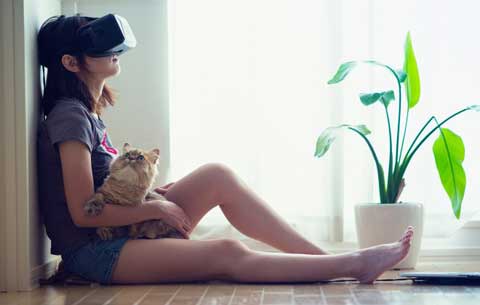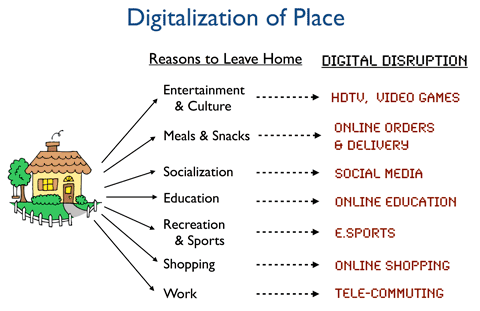
Vol. XV, No. 6, July 2015
- Editor's Travelogue
- Only 8 days left, don't miss out
- Uptick in births in 2014
- Bowling; a tale of two worlds
- The rise of young adult singledom
- Saving clients from themselves
- 90% of all new mothers are Millennials, and they have different values
- The new era of food, wine & beer festivals
- Growing your group sales
- Raising salaries can increase profits
- I want it when I want it without leaving home
- The state of family play
I want it when I want it without leaving home
Faith Popcorn, the well known futurist, author, and founder and CEO of the marketing consulting firm BrainReserve, in her Welcome to Flying Into The Future, the Medium blog, recently wrote about how the tech-enabled, on-demand economy is bringing anything we want, when we want it, into our homes. She talked about KitchenSurfing, a company that for $25 per person will have a chef come to your home, bring all the ingredients for one of three meals you've selected, cook, serve and clean up afterwards. Faith's observation is that technology makes the makers of genuine affluence - personal chefs, farm-to-table ingredients and chauffeurs (think Uber) - available on demand to the vast population. She calls it the mass upscaling of culture.
Faith's conclusion was that “consumer demand is moving fast to a luxe-when-I want-it-and-I-want-it without-leaving-home model.” She goes on to say, “With all these conveniences at our fingertips [via our digital screens], nobody will be leaving home. Not unless we really, really want to... It'll take something truly enchanting to bring us out of our cocoons: the name-droppable vacations, the must-live-it events, the one-of-a-kind experiences.
“That will be the question for us, and for companies: When we don't have to leave home, what will get us out the door?”
Faith's trend predictions have always been dead on. We think Faith is 100% on target with her observation.
She didn't touch on entertainment. The luxe-when-I want-it [entertainment]-and-I-want-it without-leaving-home model is way ahead of the luxe-food at home she discussed. With the growing availability of super fast internet connections, giant HD and now Ultra HD televisions at fast dropping prices, on-demand streaming video, massive multiplayer online video games, and on the horizon, the mass adoption of virtual reality (VR) and augmented reality (AR) for in-home use (probably in 2016), why should anyone want to leave their home for entertainment? Our company's consumer surveys and research clearly show that entertainment dollars and time are shifting to the digital realm and are mostly consumed at home. So the challenge for location-based entertainment (LBE) and family entertainment centers (FECs) becomes, “When we don't have to leave home for entertainment, what will get us out the door and into our door?”
This takes us back to a basic marketing truism we learned years ago from a very smart marketing expert we worked with on a project, Leslie Westbrook - “You can't come down from the top; you have to come up from the bottom.” What this means for entertainment is that you can't attempt to replicate the high fidelity experience of a high-end theme park or a rock concert experience on a small scale as it will be perceived as inferior. Disney learned this the hard way years ago when they tried to package the equivalent of a theme park experience in a small box called Disney Quest. Instead you have be to thought of as better than the inferior experience by offering a higher fidelity, or as Faith says, more enchanting luxe experience than it.

So if you want to get people out of the home for entertainment, you have to be a whole, whole lot better than their at-home entertainment options. You really need to be thought of as a luxury experience. With the high and fast improving sophistication of at-home entertainment, especially virtual reality with its increasing affordability of hardware and quality of content, where for example already Altspace, using eye-tracking has introduced socialization in virtual reality where people will be able to talk and share content from around the Web together in VR. “You can see if someone's rolling their eyes, see if they're looking away,” Altspace co-founder Bruce Wooden said. “You can look in a certain direction to see who's talking.” So rather than emailing your old college roommate a link to that new funny YouTube video, you might both slip into VR goggles and watch it simultaneously on a simulated TV screen, and then - still in the VR world - turn to each other to talk about it.

At-home VR is also a growing threat to live events when consumers in the near future will be able to experience the thrill of their favorite sports team from the front row or watch live concerts from the stage of their favorite bands while sitting in their lounge chair at home, what we call the live transmission of digitalization of place into the home. Already, you could have watched the 2015 U.S. Open golf championship in live streaming VR via FOX Sports at select locations. It won't be that long before it comes to your home.
It will be too expensive and too difficult for FECs to raise their bar using technology to compete with what is and will be available at very affordable prices and incredibly convenient to consumers in the home. And even if you were able to magically develop or find some over-the-top digital entertainment technology to offer in your LBE or FEC, it is sure to become obsolete in just a year or so. That's no winning formula.
Surprisingly, the answer to this challenge is a lot simpler than you may think. To get people out of the home and away from their on-demand digital entertainment and social options, you need to go back to the future with old-school entertainment - physical hands-on, socially interactive games such as bowling, bocce, ping pong, even laser tag (perhaps the only technology-based game that fits the description). These are things people can't do physically at home. These types of old-school games are very social. Socialization in the form of real world experiences that can be shared together is one of the primary motivators to get people out of their homes. That is one of the primary drivers of restaurant visits, unless of course it's only a fueling stop at a fast food joint. Restaurant dining is typically more about the social aspect of sharing the meal together than it is about the food itself.
Food and drink is the second part of winning formula for LBEs and FECs to get people out of their homes. The old-school entertainment options are no longer enough by themselves. Food and drink is one thing that virtual reality can't offer. To come up from the bottom, to offer something enticing enough to make people want to leave their homes, it takes high quality food and beverage combined with the entertainment. And it needs to be ‘destination' food and beverage, an eating and drinking experience that competes with the best stand alone restaurants in that dining and drinking category.
Today, it takes the combined synergy of old-school social games combined with destination social dining and drinking, what is called restaurantainment, to get people away from the convenience of the food and entertainment options of just staying home and getting what they want, when they want it on demand. See, it's really all about coming up from the social experience people can't have in their homes, even with friends elsewhere via VR, texting, Skype, iChat and all the other apps. It's about bringing people to a great, high fidelity, enchanting, luxe social experience that is facilitated by the entertainment, food and beverage. That is how you come up form the bottom to get people out the door to visit your LBE or FEC.
Additional reading:
- New School consumers are flocking to eatertainment restaurant & old-school game venues
- To Win Today it's all about Offering a High Fidelity Experience
Vol. XV, No. 6, July 2015
- Editor's Travelogue
- Only 8 days left, don't miss out
- Uptick in births in 2014
- Bowling; a tale of two worlds
- The rise of young adult singledom
- Saving clients from themselves
- 90% of all new mothers are Millennials, and they have different values
- The new era of food, wine & beer festivals
- Growing your group sales
- Raising salaries can increase profits
- I want it when I want it without leaving home
- The state of family play


